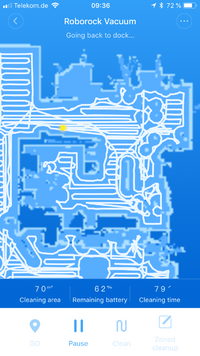2D SLAM mit GMapping: Unterschied zwischen den Versionen
Zur Navigation springen
Zur Suche springen
| Zeile 69: | Zeile 69: | ||
*[https://www.youtube.com/watch?v=6QKYMEG8w84 YouTube: Laser scanner localization and mapping] | *[https://www.youtube.com/watch?v=6QKYMEG8w84 YouTube: Laser scanner localization and mapping] | ||
*[https://openslam.org/tinyslam.html TinySlam: tinySLAM is Laser-SLAM algorithm which has been programmed in less than 200 lines of C-language code.] | *[https://openslam.org/tinyslam.html TinySlam: tinySLAM is Laser-SLAM algorithm which has been programmed in less than 200 lines of C-language code.] | ||
*[http://www.academia.edu/1208841/Towards_Model-Free_SLAM_Using_a_Single_Laser_Range_Scanner_for_Helicopter_MAV Towards Model-Free SLAM Using a Single Laser Range Scanner for Helicopter MAV] | *[http://www.academia.edu/1208841/Towards_Model-Free_SLAM_Using_a_Single_Laser_Range_Scanner_for_Helicopter_MAV Towards Model-Free SLAM Using a Single Laser Range Scanner for Helicopter MAV] | ||
*[https://www.udacity.com/course/cs373 Udacity - Artificial Intelligence for Robotics] | *[https://www.udacity.com/course/cs373 Udacity - Artificial Intelligence for Robotics] | ||
Version vom 2. August 2021, 11:46 Uhr
Autoren: offen
Betreuer: Prof. Schneider
Art: offen
Projektlaufzeit:

Thema
SLAM ist ein Verfahren mit dem sich moderne Haushaltsroboter selbst lokalisieren und dabei eine digitale Karte des Umfeldes erstellen.
Ziel
Im Rahmen dieser Projektarbeit soll ein SLAM Algorithmus nach dem Prinzip des Grid-Based FastSLAM (kurz GMapping) implementiert und evaluiert werden. Bei GMapping handelt es sich um ein Raster oder Koordinatennetz basiertes Partikelfilterverfahren nach Rao und Blackwell. Das hier beschriebene Verfahren soll in MATLAB® umgesetzt werden.
Aufgabenstellung
- Einarbeitung in das Thema GMapping anhand von Fachliteratur
- Analyse und Vergleich der bestehenden Simulationsumgebungen
- Auswahl einer geeigneten Simulationsumgebung
- Umsetzung des GMapping-Verfahrens als Simulation in MATLAB®
- Qualitative und quantitative Bewertung des umgesetzten Verfahrens
- Dokumentation von Theorie, Simulation und Ergebnissen nach wissenschaftlichem Stand
- Präsentation der Ergebnisse
Anforderung
- Wissenschaftliche Vorgehensweise (Projektplan, etc.)
- Wöchentliche Fortschrittsberichte (informativ)
- Projektvorstellung im Wiki
Getting Started
- Richten Sie zum Datenaustausch Ihren Sciebo-Account ein.
- Arbeiten Sie sich anhand der Fachliteratur in das Fachgebiet ein. Stichworte sind
- SLAM
- rao-blackwellized particle filter
- grid-based SLAM
- Stellen Sie einen Projektplan auf.
Literatur
SLAM allgemein
- SLAM for Dummies
- Probabilistic Robotics
- Simultaneous Localization and Mapping: Exactly Sparse Information Filters
- 3D Robotic Mapping: The Simultaneous Localization and Mapping Problem
- FastSLAM: A Scalable Method for the Simultaneous Localization and Mapping Problem in Robotics
- think Bayes
Partikelfilter
- Particle Filter Explained without Equations
- Particle Filter - 5 Minutes with Cyrill
- Particle Filter and Monte Carlo Localization (Cyrill Stachniss, 2020)
- MSR Course - 07 Particle Filter (Stachniss)
GMapping
- Occupancy Grid - 5 Minutes with Cyrill
- Occupancy Grid Maps
- SLAM Course - 13 - Grid-Based SLAM with Rao-Blackwellized PFs
MATLAB Beispiele
- SLAM Package of Tim Bailey
- MATLAB implementation of gmapping algorithm
- 2-D and 3-D simultaneous localization and mapping
Weblinks
- SLAM 4 Dummies
- EKF-SLAM Toolbox for MATLAB
- YouTube:SLAM in MATLAB (Weighted Scan Matching & Wheel Odometry)
- YouTube: Laser scanner localization and mapping
- TinySlam: tinySLAM is Laser-SLAM algorithm which has been programmed in less than 200 lines of C-language code.
- Towards Model-Free SLAM Using a Single Laser Range Scanner for Helicopter MAV
- Udacity - Artificial Intelligence for Robotics
- Intro to Statistics
- EKF-SLAM TOOLBOX FOR MATLAB
- ROS (Robot Operating System)
- C4B Mobile Robots Example Matlab Code
- Simultaneous Localisation and Mapping (SLAM) in MATLAB
Siehe auch
→ zurück zum Hauptartikel: Studentische Arbeiten